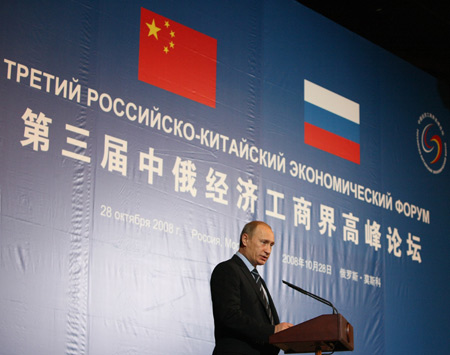
China Secures Trade Surplus With Russia
Publication: Eurasia Daily Monitor Volume: 7 Issue: 184
By:

Russia has sought to expand its trade with China in an apparent bid to prop up what was officially denoted as the strategic partnership between the two nations. Meanwhile, as bilateral trade recovered, China has regained a surplus in its trade with Russia. The official visit of Russian President, Dmitry Medvedev, to China on September 26-28 was aimed at boosting bilateral economic ties. In an interview ahead of the visit, Medvedev noted that bilateral trade reached $25 billion in the first half this year and urged raising the annual figure to $50 billion in 2010. Medvedev described energy as a key area of bilateral economic ties (Interfax, September 26).
From January to August 2010, Russia’s trade with China reached $35.34 billion or 47.6 percent up year-on-year. Russian trade representative in Beijing, Sergei Tsyplakov, said that Chinese exports to Russia, reached $17.89 billion or 76.7 percent up year-on-year. Russian exports to China amounted to $17.45 billion or 27.7 percent up year-on-year, according to Tsyplakov, adding that China had recorded a $440 million surplus in its trade with Russia (Interfax, September 26).
China achieved a surplus in its trade with Russia mainly due to a decline in industrial exports from Russia. Russian officials had argued that bilateral trade would recover this year. In 2010, Russia’s trade with China is likely to reach $54 billion to $56 billion, Tsyplakov said. However, Russian exports to China are still dominated by commodities. Oil supplies amount to approximately 50 percent of Russian exports to China. From January to August 2010, oil deliveries to China totaled 9.8 million tons or 11.5 percent up year-on-year, Tsyplakov explained (Interfax, September 26). As a result, Russia became China’s fourth largest oil supplier after Saudi Arabia, Angola and Iran. In 2009, Russian oil supplies amounted to 7.8 percent of China’s total oil imports, compared to 6.5 percent in 2008.
Russian officials have been keen to increase trade between Russia and China in an apparent bid to cement the bilateral partnership. In January 2006, the then Russian President, Vladimir Putin, announced plans to increase bilateral trade to $80 billion annually by 2010. Initially, both countries appeared to move fast towards achieving that goal. In 2007, Russia’s trade with China reached $48.16 billion or 44.3 percent up year-on-year.
In 2008, bilateral trade amounted to $56.8 billion or 18 percent up year-on-year. But in 2009, Russia’s trade with China reached $38.8 billion or some 32 percent down year-on-year, according to Russian and Chinese statistics. Energy projects were expected to dominate the agenda of Medvedev’s visit to China. On September 27, Medvedev and President Hu Jintao officially announced the completion of the Skovorodino-Daqing pipeline. During the ceremony, Medvedev praised the bilateral energy partnership. However, the pipeline announcement was a largely symbolic gesture aimed at highlighting the bilateral energy partnership. The Chinese are still due to complete the pipeline’s 960-kilometer section from its border with Russia to Daqing by the end of October, while actual supplies are expected to start only in January 2011.
In April 2009, the Chinese and Russian governments clinched a deal under which Russia will supply China with 15 million tons of oil per annum for 20 years in exchange for $25 billion in loans to the Russian state-run companies Rosneft and Transneft. Subsequently, Transneft moved to build a branch from the East Siberia Pacific Pipeline (ESPO) to China. The branch’s construction was started in April and was completed on August 29, 2010 (Interfax, September 26).
However, during Medvedev’s visit to China on September 26-28 both sides announced no agreements on Russian gas supplies to China. Lukoil was widely expected to sign a cooperation agreement with CNPC, but no announcements were made. Meanwhile, Moscow has also moved to increase Russian electricity exports to China. From January to August 2010, Russia exported about 631 million kilowatt hours (kwh) to China or 124 percent up year-on-year.
In recent years, Moscow and Beijing have struggled to agree on terms for electricity trade. In February 2007, China halted imports of Russian electricity, citing disagreements on pricing. But both sides resolved outstanding issues and in March 2009 Russia re-started electricity exports to China. Last year, Russian suppliers exported about 900 million kwh to China. Russian energy companies reportedly aim to export 60 billion kwh by 2020.
The Kremlin has long wanted to modernize its economic ties with China and move away from trade dominated by commodities. During his visit to China, Medvedev urged Chinese investors to invest in Russia’s hi-tech and innovation sectors. Medvedev suggested exploring possible joint projects to develop and produce civilian aircraft (Interfax, September 26).
Despite official pronouncements, Chinese investments in Russia remain at a very low level. In the first half of this year, Chinese investments in Russia reached $260 million or 58.5 percent up year-on-year, according to Tsyplakov. As a result, China’s total investments in Russia reached $2.28 billion, Tsyplakov said. Chinese investors focused on forestry, textile and trade projects in Russia (Interfax, September 26).
Therefore, trade between Russia and China apparently continues to be dominated by commodities as Russia largely acts as an energy supplier to China. It remains to be seen whether hi-tech sectors could play any significant role in bilateral economic ties.




